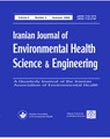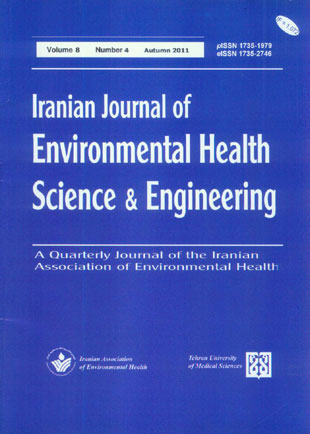فهرست مطالب

Iranian Journal of Environmental Health Science and Engineering
Volume:5 Issue: 1, Winter 2008
- تاریخ انتشار: 1386/11/20
- تعداد عناوین: 10
-
-
Pages 1-10A carbonaceous adsorbent prepared from an indigenous waste and treated by acid was tested for its efficiency in removing metal ions of Fe(II), Co(II) and Ni(II). The process parameters studied included agitation time, initial metal ion concentration, carbon dosage, pH, other ions and temperature. The kinetics of adsorption followed first order reaction equation and the rate was mainly controlled by intraparticle diffusion. Freundlich and Langmuir isotherm models were applied to the equilibrium data. The adsorption capacity obtained from the Langmuir isotherm plots was found around 28mg/g for all selected metal ions at an initial pH of 6. The temperature variation study showed that the metal ions adsorption is endothermic and spontaneous with increased randomness at the solid solution interface. Significant effect on adsorption was observed on varying pH of the metal ion solutions. The type I and II isotherms obtained, positive H0 values, pH dependent results and desorption of metal ions in mineral acid suggests that the adsorption of metal ions on this type of adsorbent involves both chemisorption and physical adsorption mechanisms.Keywords: Activated carbon, metal ions, adsorption isotherms, kinetic and thermodynamic parameters, intraparticle diffusion, regeneration pattern
-
Pages 11-18Humic acid was used as hydrophobic organic matter and NaCl as background electrolyte. Results showed that flux reduction increased with increasing ionic strength and humic acid concentration, and with lower pH. The rejection efficiency of organic and salt decreased with the decrease in pH and increase in ionic strength, because of osmotic pressure increase, leading to permeate flux decline and decrease in salt rejection. In addition, the improved salt rejection was likely due to Donnan exclusion by humic material close to membrane surfaces. The average rejection efficiency of humic acid and salt ranged between 91.2%-95.25% and 63.6%-80%, respectively. Dissolved organic carbon concentration was less than 0.57mg/L in permeate for all experiments. With increasing organic concentration, the charge of the membrane surface has become more negative due to the adsorption of organic foulants on the membrane surface, and thus increased the electrostatic repulsion. However, the increasing surface charge had the potential to result in a larger molecular weight cut-off of a fouled membrane due to membrane swelling which can lead to lower rejection solutes. Therefore, results of this study indicated that membrane fouling may significantly affect the rejection of organic and ion solute.Keywords: Natural organic matter, humic acid, membrane fouling, nanofiltration, water treatment
-
Pages 19-24Shrimp waste is the most important chitin source for commercial use. In this study chitin and chitosan were extracted from Penaeus semisulcatus waste collected from a shrimp processing landing center situated at Persian Gulf in south of Iran by chemical and microbial methods. Chitin and chitosan were extracted by alkali-acid treatment and the yields were 510 and 410mg/g, respectively. Demineralization is an important step in the chitin purification process from shrimp waste. Chemical extraction method included the use of NaOH solution and acetic acid. In microbial extraction, organic acids (lactic acid) produced by probiotic bacteria was used to demineralize microbial deproteinized shrimp shells. The study showed that the effectiveness of using lactic acid bacteria especially added Fe (NO3)3 as extra nitrogen source for demineralization of shrimp shells than chemical method (1750 against 810mg/g). Chitin and chitosan extracted from shrimp waste by chemical and microbial methods was crystalline powder, non-harmful and odorless, white and off-white, respectively. The moisture content was calculated as 63.8%. The amount of Ca, Fe, Cu and Mn present in the shells was 168, 35.58, 38.28 and 6.72mg/L, obtained by atomic absorption spectroscopy, respectively. The amount of calcium in the shells was 25 times higher than manganese. The results suggested Lactobacillus plantarum (PTTC 1058) is an attractive source of recovery for chitin and chitosan.Keywords: Shrimp waste, chitin, chitosan, organic acids, lactic acid bacteria
-
Pages 25-34The arbitrary disposal through land-fill sites and also the unscientific management of solid wastes generated by domestic, commercial and industrial activities leading to serious problems of health, sanitation and environmental degradation in India demand an immediate proper solid waste disposal planning otherwise it may cause a serious problem, especially in small and medium-sized cities/towns if proper steps are not initiated now. The present paper aims to develop decision support systems to allocate the best landfill disposal site among the given alternative sites for Vidya Vihar, Pilani, Rajasthan, India. The technique is applied to determine the overall strategy for planning of solid waste disposal and management, while taking into account its environmental impact, as well as economical, technical and sustainable development issues. The model effectively reflects dynamic, interactive, and uncertain characteristics of the solid waste management system and provides decision-makers with a decision tool to make a better decision while choosing a municipal solid waste management strategy.Keywords: Decision making, solid waste management, landfill siting, planning
-
Pages 35-42There have been numerous sediment quality guidelines developed to monitor the sediments. Sediment quality guidelines are very useful to screen sediment contamination by comparing sediment contaminant concentration with the corresponding quality guideline, provide useful tools for screening sediment chemical data to identify pollutants of concern and prioritise problem sites and relatively good predictors of contaminations. However, these guidelines are chemical specific and do not include biological parameters. Aquatic ecosystems, including sediments, must be assessed in multiple components (biological data, toxicity, physicochemistry) by using intregrated approaches in order to establish a complete and comprehensive set of sediment quality guidelines. Numerous sediment quality guidelines Washington Department of Ecology Sediment Quality Guideline, Australian and New Zealand Environment and Conservation Council, Swedish Environmental Sediment Quality, Screening Quick Reference Table, Portuguese Legislation on the Classification of Dredged Materials in Coastal Zones and Interim Sediment Quality Guideline for Hong Kong) have been applied to the Mengkabong lagoon mangrove sediment and discussed. The most appropriate guideline that meets the prioritization criteria consistent with international initiatives and regulations is interim sediment quality values for Hong Kong. The guideline verifies that all the metals are below the Interim Sediment Quality Value-low. However, site-specific, biological testing and ecological analysis of exisiting benthics community structure related to sediment contamination are needed for final decision making in the case of Mengkabong lagoon.Keywords: Mangrove, sediment, sediment quality guidelines
-
Pages 43-50Unplanned urban developments have led to changes in uncontrollable urban spatial structure. For this reasons, informed guidance, principle organization and spatial planning are necessary for urban sprawl and development. In this research, different forms of urban development were considered and development basic barriers including rivers, topography, geology, ecological conditions, facilities and industries were determined and the role of each one was surveyed. Development trends that are based on effective parameters especially environmental impacts were modeled with Geographic Information Systems. The quality of urban planning and management can be upgraded when available and valid data are handled in an advanced manner with the aid of Geographic Information Systems. The innovative technology can support planning and decision making by offering relatively quick response on analytical questions and monitoring issues. Experienced expert determined the degree and primacy of urban sprawl and development parameters generally and for nalos case study, these parameters and criteria and their weights were marked, then were modeled with Geographic Information Systems for nalos developments. With using GIS and it capabilities in calculation of land size forecasting for Nalos development and its positioning we could take a step in planning directions such as sustainable development achievements.Keywords: GIS, planning, environmental impact, modeling, physical development
-
Pages 51-58Field experiments were conducted during 2002-2003 on clay loam, sandy loam and red loam soil at Sivapuri, Chidambaram, Tamil Nadu, to evaluate the efficacy of vermicompost on the physico-chemical and biological characteristics of the soils and on the yield and nutrient content of blackgram - Vigna mungo, in comparison to inorganic fertilizers nitrogen, phosphorous, potassium. Vermicompost had increased the pore space, reduced particle and bulk density, increased water holding capacity, cation exchange capacity, reduced pH and electrical conductivity, increased organic carbon content, available nitrogen, phosphorous, potassium and microbial population and activity in all the soil types, particularly clay loam. The yield and quality (protein and sugar content in seed) of blackgram was enhanced in soils, particularly clay loam soil. On the contrary, the application of inorganic fertilizers has resulted in reduced porosity, compaction of soil, reduced carbon and reduced microbial activity.Keywords: Clay loam, sandy loam, red soil, physico, chemico, biological properties, vermicompost, blackgram
-
Pages 59-64The indoor air quality of 131 restaurant kitchens in Tehran was investigated from May to September 2006. Gas stoves use in restaurant kitchens is a major source of indoor combustion, product carbon monoxide and nitrogen dioxide. The study focused on one of the busy zones located in the southwest and central part of the city. Measurements were done for indoor and outdoor air pollutants, carbon monoxide and nitrogen dioxide; ambient temperature and relative humidity were also measured. Result indicated that the mean levels of CO and NO2 in restaurant kitchens were below the recommended limit of 25 and 3ppm, respectively. Correlations between indoor and outdoor air quality were performed consequently. Results of the mean ambient temperature and relative humidity were above the guideline. In this study the mean levels of CO and NO2 gas cooking in restaurant kitchens were found to be lower compared with the similar studies.Keywords: Indoor air quality, restaurant kitchens, gas stove, cooking, CO, NO2
-
Pages 65-72Forty six workers from an ink factory were included in this study, in which, passive badge sampler and questionnaire interview were used to assess the concentrations of airborne exposure to ethylene glycol monobutyl ether during work shifts and to understand the subjects'' working habits. The geometric mean value (95% confidence interval) of the airborne ethylene glycol monobutyl ether concentrations was 0.12(0.08-0.19)ppm, with a range of <0.02-1.82ppm. The exposure group was exposed to statistically significantly higher ethylene glycol monobutyl ether concentrations than the control group (geometric mean value: 0.14vs. 0.03ppm; P=0.017). Some chromatograms showed that subjects were co-exposed to m-xylene, ethylene glycol monomethyl ether, and ethylene glycol monoethyl ether acetate. According to the completed questionnaires, subjects might also be exposed to 1,2,4,5-tetramethylbenzene, propylene glycol ethers, ethanol, 1,2,4-trimethylbenzene, methanol and diisononyl phthalate. This study also suggests that, the Taiwan occupational time-weighted average level of ethylene glycol monobutyl ether be reconsidered with a view to being lowered.Keywords: Occupational exposure, ethylene glycol monobutyl ether, passive badge, time-weighted average
-
Pages 73-77In the present study removal of chromate anion (CrO42-) from a synthetic aqueous solution by a synthesized MCM-41/ZSM-5 composite and its modified form with the anionic surfactant of hexadecyl-teri methyl ammonium bromide; (surfactant modified composite) was investigated. According to the data obtained from batch test of MCM-41/ZSM-5 composite and surfactant modified composite, it is obvious that modification of the composite with anionic surfactant improves its affinity toward the oxyanion (917mL/g for MCM-41/ZSM-5 composite in comparison to 1870mL/g for surfactant modified composite). It was concluded that sorption capacity and selectivity of the composite will be remarkly improve toward chromate anion by modification of its surface by a surfactant; therefore surfactant modified composite is a suitable candidate for removal of chromate anion from contaminated solutions.Keywords: Chromate, MCM, 41/ZSM, 5 composite, wastewater


